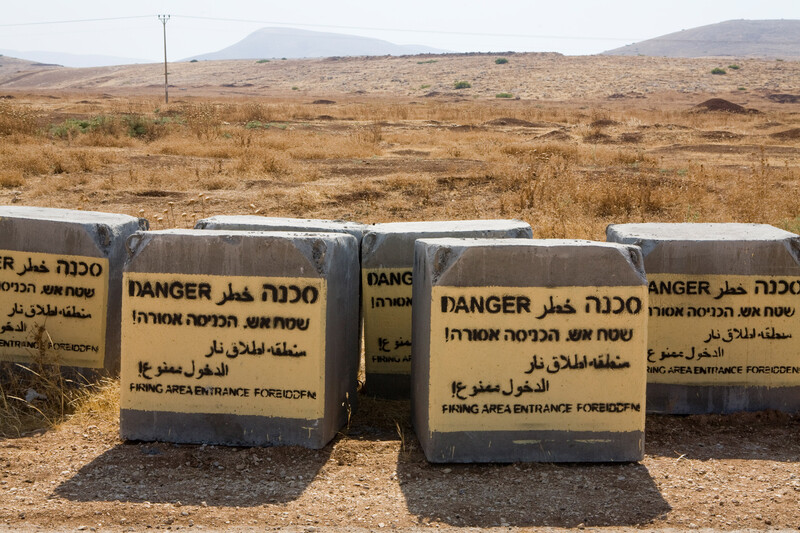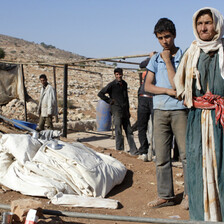The Electronic Intifada Jordan Valley 16 September 2013

Israel has declared much of the Jordan Valley a closed military zone.
ActiveStillsJIFTLIK, Occupied West Bank (IPS) - In the Jordan Valley, contrasts are stark. Lush agricultural fields and fenced-in greenhouses belong to the Israeli settlements that dot the landscape and benefit from the area’s abundant water supply. Yet Palestinian farmers, denied access to their lands and other resources by the Israeli authorities, struggle to cultivate the most basic crops and make a living wage.
“It’s a struggle for the farmers,” Palestinian farmer Ahmad Said Moahri said from his home in Jiftlik, a Palestinian village in the Jordan Valley. “The farmers lose money sometimes by farming the land, but they cannot leave or Israel will take it.”
The 46-year-old owns 47 dunams (one dunam is equal to 1,000 square meters) of agricultural land in Jiftlik. He harvests vegetables — eggplant, tomatoes, zucchini and more — on 27 dunams, and rents the remainder to another local farmer.
While Moahri earns between 15,000 to 20,000 shekels ($4,200 to $5,600) annually through farming for five months each year — between September and January — he takes on a second job to support his family: packaging Israeli dates at a factory in Massua, an illegal Israeli settlement near Jiftlik.
“From the beginning, when the settlement was established, Israel gave them everything. There is no government support [for us], but in the settlement, there is,” said Moahri, who is paid 10 shekels ($2.80) per hour, and makes between 12,000 to 14,000 shekels ($3,400 to $4,000) each year from working in the settlement.
According to a report published by the Maan Development Center, 1,800 dunams are allocated to agriculture in Massua, and the settlement produces eggplant, pepper, zucchini, cucumbers, watermelons, melons and dates.
“The geographical location of settlements in the Jordan Valley has been determined by the important potential agricultural growth in the region. In addition, these agricultural settlements were established and maintained as export-oriented settlements,” Maan reported (“Cultivating dispossession: Israeli settlements in the Jordan Valley” [PDF]).
The Jordan Valley constitutes nearly 30 percent of the West Bank; 87.5 percent of this area is located in Area C, which falls under complete Israeli military control. According to 2009 data, some 9,300 Israeli settlers and 65,000 Palestinians live in the Jordan Valley (“Dispossession and exploitation,” B’Tselem, May 2011 [PDF]).
Potential
Palestinians are prohibited from accessing almost 95 percent of the Jordan Valley, as half the land is being used by Israeli settlements and the Israeli army has declared another 45 percent as closed military zones, which are off-limits to Palestinians.
The Jordan Valley is known as the Palestinian breadbasket, as most of the West Bank’s arable land is located there. In a 2010 report, the World Bank stated that if Palestinians could access 50,000 more dunams of land and additional water resources in the area, they could earn approximately $1 billion annually (“The underpinnings of the future Palestinian state,” 21 September 2010 [PDF]).
This economic potential is not lost on Palestinian, or Israeli, leaders. As the “peace talks” between Palestinians and Israelis continue, the Palestinian Authority leadership has once again stated that the creation of a Palestinian state is impossible without control of Jericho and the Jordan Valley.
“We are committed to that. We have said that more than once,” Mahmoud Abbas, the PA leader, said last month (“Abbas: No state without Jericho, Jordan Valley,” Ma’an News Agency, 16 August 2013).
The Israeli government provides generous economic support to its settlements and settlement industries operating in the Jordan Valley.
In contrast, the PA government in Ramallah has done very little to support Palestinians in the area. The PA has never allocated more than 1 percent of its budget to the agricultural sector, and between 2001 and 2005, more than 85 percent of that budget went to paying PA salaries.
PA “doesn’t care”
The overall contribution of agriculture to the Palestinian gross domestic product dropped from approximately 13.3 percent in 1994 to 5.7 percent in 2008, according to a report released by Al-Shabaka, the Palestinian policy network (“Farming Palestine for freedom,” 2 July 2012).
“The support we get as farmers in the Jordan Valley is less than what we need,” Moahri said. “The government does not care about the agricultural situation. Agriculture was damaged because the PA neglected it. They didn’t change their strategy.”
Moayyad Bsharat heads the Jericho office of the Union of Agricultural Work Committees, which supports Palestinian farmers in the West Bank and Gaza Strip. He said that because it is bound by the Oslo accords of the early 1990s, the PA is unable to support the most marginalized Palestinian farmers working in Area C.
“The first [solution is] to end the Oslo agreement. The solution in the Jordan Valley is political, 100 percent. We are talking about rights. The farmers want to go to their natural resources — the land, the water and the cultivation — and these things will not be done on the ground without a big political solution,” Bsharat said.
In the meantime, Israel aims to force Palestinians to leave the area, and exploits the resources and economic potential of the Jordan Valley, Bsharat added.
“The Israeli settlements have 3 million palm trees in the Jordan Valley, which yearly gives millions of shekels to the Israeli government. They have the grapes, flowers … all these things are exported,” he said.
Farmer Ahmad Said Moahri sees his work as a form of resistance.
“I love the land and our home is here. For this reason, I cannot leave the land. There is not a day that I won’t visit, or look at, or take care of my land.”
All rights reserved, IPS - Inter Press Service (2013). Total or partial publication, retransmission or sale forbidden.





